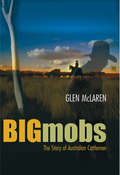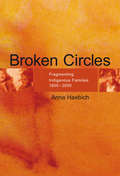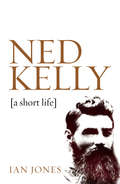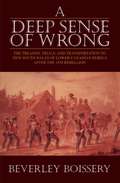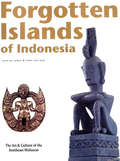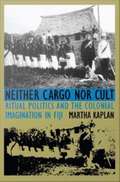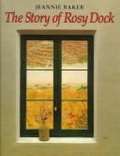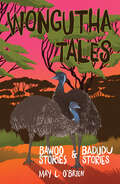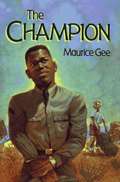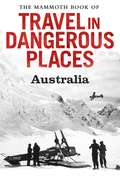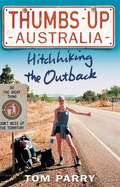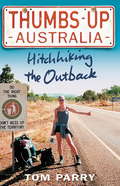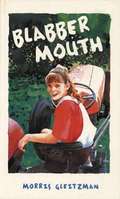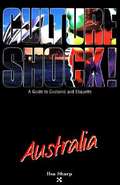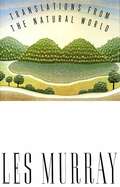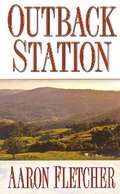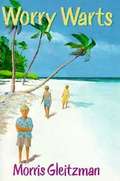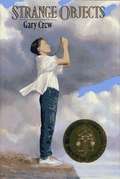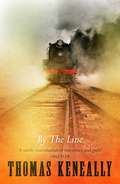- Table View
- List View
Big Mobs: The Story of Australian Cattlemen
by Glen MclarenPreviously overshadowed in the public imagination by notions of American cowboys and the wild west, Australian stockmen are given the place they so richly deserve in pastoral and Australian history in this insightful study. From the lonely months on a long cattle drive to the boots they wore and the places they lived in, the stockmen and their unique way of life is intelligently explored in this comprehensive work.
Broken Circles
by Anna HaebichThis major work reveals the dark heart of the history of the Stolen Generations in Australia. It shows that, from the earliest times of European colonization, Aboriginal Australians experienced the trauma of loss and separation, as their children were abducted, enslaved, institutionalized, and culturally remodeled. Providing a moving and comprehensive account of this tragic history, this study covers all Australian colonies, states, and territories. The analysis spans 200 years of white occupation and intervention, from the earliest seizure of Aboriginal children, through their systematic state removal and incarceration, and on to the harsh treatment of families under the assimilation policies of the 1950s and 1960s. The resistance struggle and achievements of Aboriginal people in defending their communities, regaining their rights and mending the broken circles of family life provides a compelling parallel story of determination and courage.
Ned Kelly: A Short Life
by Ian Jones'the best Kelly biography by a country mile' - The AustralianThe definitive biography of Ned Kelly - and a superb description of his times. A bestseller since it was first published, Ned Kelly: A Short Life is acknowledged as being the definitive biography. Ian Jones combines years of research into all the records of the era and exhaustive interviews with living descendants of those involved, to present a vivid and gripping account of one of Australia's most iconic figures. `It will probably stand as the definitive account of Kelly?s life and its meaning?a work of prodigious scholarship, vivid reportage and sharp analysis?the most detailed portrait of the outlaw ever written? - Rod Moran, West Australian`the definitive biographical work? - Dr John McQuilton, author of The Kelly Outbreak
A Deep Sense of Wrong: The Treason, Trials and Transportation to New South Wales of Lower Canadian Rebels
by Beverley BoisseryIn 1839 fifty-eight men left Montreal for the penal colony of New South Wales. They were ordinary people who had been caught up in the political whirlwind of the 1838 rebellion. Even though they were all civilians, they had been tried by court martial. Convicted of treason, their properties forfeited to the crown, they paid a heavy price for rebellion. And as convicts in Australia, they were considered the lowest of a bad lot. During their years there, however, they earned the respect of Sydney’s citizens.
Forgotten Islands of Indonesia: The Art & Culture of the Southeast Moluccas
by Joss Van Dijk Nico DejongeThis beautiful book contains fascinating text and over 170 unique photographs of one of the most interesting but least well known cultures in the Indonesian Archipelago.The traditional art of Maluku Tenggara, the Southeast Moluccas, is among the most sophisticated and expressive in the world. Simple tools were used to create masterpieces in wood, stone, textiles and precious metals, while the plaited work and earthenware of these islands are also of the very highest quality.the colonial period plunged the region into hopeless isolation. During the harsh rule of the Dutch many traditional woks of art, especially ancestor statues, were destroyed. Later, collectors stripped the islands of their masterpieces and the culture of Maluka Tenggara was forgotten.Forgotten Islands of Indonesia presents a unique survey of the finest examples of Southeast Moluccan art. This volume contains many photographs and descriptions which have never before been published. Set against the cultural background and supplemented by rare photographs taken in the field, the material culture of Maluku Tenggara, which is regarded as one of the most fascinating areas of Indonesia, is presented here comprehensively for the first time.
Forgotten Islands of Indonesia
by Joss Van Dijk Nico DejongeThis beautiful book contains over 170 unique photographs and pictures of one of the most interesting but least well known cultures in the Indonesian Archipelago.The traditional art of Maluku Tenggara, the Southeast Moluccas, is among the most sophisticated and expressive in the world. Simple tools were used to create masterpieces in wood, stone, textiles and precious metals, while the plaited work and earthenware of these islands are also of the very highest quality.the colonial period plunged the region into hopeless isolation. During the harsh rule of the Dutch many traditional woks of art, especially ancestor statues, were destroyed. Later, collectors stripped the islands of their masterpieces and the culture of Maluka Tenggara was forgotten.Forgotten Islands of Indonesia presents a unique survey of the finest examples of Southeast Moluccan art. This volume contains many photographs and descriptions which have never before been published. Set against the cultural background and supplemented by rare photographs taken in the field, the material culture of Maluku Tenggara, which is regarded as one of the most fascinating areas of Indonesia, is presented here comprehensively for the first time.
Forgotten Islands of Indonesia
by Nico Dejonge Joss Van DijkThis beautiful book contains over 170 unique photographs and pictures of one of the most interesting but least well known cultures in the Indonesian Archipelago.The traditional art of Maluku Tenggara, the Southeast Moluccas, is among the most sophisticated and expressive in the world. Simple tools were used to create masterpieces in wood, stone, textiles and precious metals, while the plaited work and earthenware of these islands are also of the very highest quality.the colonial period plunged the region into hopeless isolation. During the harsh rule of the Dutch many traditional woks of art, especially ancestor statues, were destroyed. Later, collectors stripped the islands of their masterpieces and the culture of Maluka Tenggara was forgotten.Forgotten Islands of Indonesia presents a unique survey of the finest examples of Southeast Moluccan art. This volume contains many photographs and descriptions which have never before been published. Set against the cultural background and supplemented by rare photographs taken in the field, the material culture of Maluku Tenggara, which is regarded as one of the most fascinating areas of Indonesia, is presented here comprehensively for the first time.
Neither Cargo Nor Cult
by Martha KaplanIn the 1880s an oracle priest, Navosavakadua, mobilized Fijians of the hinterlands against the encroachment of both Fijian chiefs and British colonizers. British officials called the movement the Tuka cult, imagining it as a contagious superstition that had to be stopped. Navosavakadua and many of his followers, deemed "dangerous and disaffected natives," were exiled. Scholars have since made Tuka the standard example of the Pacific cargo cult, describing it as a millenarian movement in which dispossessed islanders sought Western goods by magical means. In this study of colonial and postcolonial Fiji, Martha Kaplan examines the effects of narratives made real and traces a complex history that began neither as a search for cargo, nor as a cult. Engaging Fijian oral history and texts as well as colonial records, Kaplan resituates Tuka in the flow of indigenous Fijian history-making and rereads the archives for an ethnography of British colonizing power. Proposing neither unchanging indigenous culture nor the inevitable hegemony of colonial power, she describes the dialogic relationship between plural, contesting, and changing articulations of both Fijian and colonial culture. A remarkable enthnographic account of power and meaning, Neither Cargo nor Cult addresses compelling questions within anthropological theory. It will attract a wide audience among those interested in colonial and postcolonial societies, ritual and religious movements, hegemony and resistance, and the Pacific Islands.
The Story of Rosy Dock
by Jeannie BakerThe plant rosy dock is not native to Australia. A newcomer who settled in the desert area of central Australia planted it in her garden. After each rare period of rain the desert blossoms, and over the years the seeds of this plant have blown their way across south, central and western Australia. Full-color collage illustrations.
Wongutha Tales
by May O'BrienFirst published as individual titles in 1992, May O' Brien' s stories were ground-breaking publications, presenting traditional Indigenous stories in a bilingual text and giving a unique insight into learning English as a second language from a First Nations perspective. Classic tales such as How Crows Became Black and Why the Emu Can' t Fly are still as fresh and appealing as ever for a new generation of junior readers. Plus May' s simple pronunciation guide for Wongutha words are perfect learning activities for the classroom.
The Champion
by Maurice GeeIn 1943 twelve-year-old Rex sees his quiet New Zealand village dramatically changed by the arrival of a black American soldier on leave from the war.
Hestorian Taotao Tano': History of the Chamorro People
by Political Status Education Coordinating CommissionCONTENTS PART I: CHAMORRO PREHISTORY Introduction UNIT 1: The Quest for a Home and Identity Section A Clues to the Puzzle Clues from Ancestral Remains Clues from Language Clues from Tools and Pottery Clues from Plants Putting the Clues Together Section B Looking for a Home Section C The Pacific Section D The Navigators Section E Settlements UNIT 2: The Life of the Ancient Chamorros Section A Economics and Society Section B Home and Family Section C The Manmaga'lahi and Manmaga'haga Section D The Guma' Uritao Section E Marriage and Home Section F Beliefs Section G Magic and Medicine PART II: CONTACT WITH THE EUROPEANS Introduction UNIT 1: Contact with the Europeans Section A A Tale about How it might have Happened Section B The Search for Wealth and Power Section C Conversion, Conquest and Colonization Section D The Religion of the Chamorros UNIT 2: Bringing Christianity to the Chamorros Section A Padre San Vitores and the Chamorros Section B Trouble Over Differences Section C Chamorro Leaders Who Rebelled Section D Guam in the 18th and 19th Centuries Section E The Continuing Role of Chamorro Women English Glossary Chamorro Glossary
The Mammoth Book of Travel in Dangerous Places: Australia (Mammoth Books #348)
by John KeayLandfall at Botany Bay - James CookThe son of a Yorkshire farm labourer, Cook won distinction as a naval hydrographer but was still a controversial choice to command a voyage of scientific observation to the Pacific in 1768. Its results, including the first coastal surveys of New Zealand and eastern Australia, led to a second voyage to the south Pacific and a third to the north Pacific, during which he was killed in a fracas with the Hawaiians. It was a tragic end for one whose humble origins disposed him to respect indigenous peoples. "They are far happier than we Europeans", he noted of Australia's aborigines following a brief encounter at Botany Bay (Sydney), the first European landing on the Pacific coast, in 1770.Escape from the Outback - Charles SturtAfter pioneering journeys to the Darling and Murray rivers, in 1844-5 Sturt headed north for the heart of Australia. Since the continent appeared to have few seaward draining rivers it was assumed that, alike Africa, it must boat an inland lake region; a boat was therefore included amongst the expeditions equipment. But Sturt failed to reach the geographical centre of the continent, and the largest stretch of water found was at Coopers Creek, later to figure so prominently in the endeavours of Burke and Wills. Sturt's painful retreat during the hottest summer on record formed a fitting prelude to the Wills saga.Death at Coopers Creek - William John WillsIn early 1861 Robert O'Hara Burke, William Wills and John King reached Australia's northern coast on the Gulf of Carpentaria, thus completing the first transcontinental crossing. Returning the way they had come, after four months of appalling hardship they staggered into Sturt's Coopers Creek where men and supplies had been left to await their return. They were just eight hours too late; the relief party, despairing of their return, had left that very morning. One of exploration's most poignant moments was followed by one of its most protracted tragedies as the expedition tried to extricate itself, failed, faded, and died. Only King survived; three months later he was discovered living with the aborigines; Will's heartbreaking journal was found lying beside his skeleton.To See the Sea - John McDouall StuartModest, dedicated, immensely tough and thoroughly congenial, Stuart was very much an explorer's explorer. With little support or fuss he began probing north from Adelaide in the late 1850's. In 1860 he was the first to reach the centre of the continent, thus completing the work of Sturt. Although Burke and Wills just beat him in the race to cross the continent, Stuart's 1862 route was much longer and more difficult; and he did actually reach the sea. He was also to return alive.
Thumbs Up Australia: Hitchhiking the Outback
by Tom ParryOn the Road meets Down Under in this really rough guide to the adventures of an enthusiastic hitchhiker and his reluctant girlfriend on their quest for the real Australia. Hitching lifts with the desert's dodgiest drivers and taking breaks in the roughest roadhouses, this is Tom Parry's witty, warts-and-all tale of hitchhiking 8,000 miles across - and around - the Australian outback with his thumb, his backpack and his French girlfriend, Katia. As the couple hitch their way around the near empty highways, they encounter as wide a cross-section of Aussie society as you could ever hope to meet. In cattle stations, Aboriginal communities, remote waterholes, caravan parks, hippy communes and roadhouses, they see a country that remains as extraordinary today as it was for the first nineteenth century settlers. Loosely following the routes carved out by the legendary explorers who first traversed the great continent, the couple get to grips with the country's fascinating history. Set against a backdrop of the real Australia - not 'as seen on TV'- "Thumbs Up Australia" is full of wonderful anecdotes and endearing tales of some of the country's most idiosyncratic characters, from the grizzled Aboriginal elder with his tales of dreamtime, to an amphetamine-swallowing road train driver. And at the end of their journey, it is ironically Katia who suggests thumbing a lift to the airport!
Thumbs Up Australia
by Tom ParryWith anecdotes and endearing tales of characters met along the way, Thumbs Up Australia follows the exploits of an English hitchhiker and his reluctant French girlfriend as the two uncover a never-before-seen Australia. Tom Parry carries the reader through almost-empty highways and a distinctively Aussie society on a journey of 8,000 miles-with just as many adventures.
Blabber Mouth
by Morris GleitzmanSet in Australia, this humorous and touching story of the misadventures of a clever girl who cannot speak and her social misfit of a father will delight readers.
Culture Shock! Australia
by Ilsa SharpIn addition to explaining Australia to newcomers and visitors in the hope of bridging culture gaps and improving the chances of mutual empathy and friendship, it is the author's wish that Australians will, through this book, see themselves through outsiders' eyes.
Transit of Venus
by Julian EvansJulian Evans won a host of awards for this smart, funny, and thoughtful travelogue through the South Pacific islands. Evans was raised in Australia, but moved to England as a teenager, and forever longed to return to the Pacific of his childhood. He sails on a freighter from Australia to cross the Pacific, stopping at a series of ever more remote islands. Along the way he discusses the politics, history, and culture of the Pacific Islanders and the Europeans with whom they so uneasily co-exist. English, not American, spelling and punctuation; also dialect here and there
Translations from the Natural World
by Les MurrayThe centerpiece of this collection of poems is "Presence," a sequence of forty "translations from the natural world" about a variety of settings and their amazing denizens. Lyre birds, honeycombs, sea lions, possums, all act as spurs for Murray's protean talent for description and imitation.
Misery Guts
by Morris GleitzmanThe adventures of twelve-year-old Keith as he tries to cheer up his parents in many different ways include painting their shop in bright colors and convincing them to move from gloomy England to a place called Paradise.
Outback Station (Outback Saga #2)
by Aaron FletcherThe Convict: David Kerrick is a man with nothing left to lose. Betrayed by the woman he adores, deported to Australia for murdering her lover, he has lost the will to live until the lure of the outback claims his soul. Captivated by the sweeping wild beauty of the land, its freedom and mystery, he sets out to make a piece of it his own. Battling drought and dingoes, bushfires and bushrangers, he lives for the moment until the past comes back to haunt him... The Colonist: Wealthy and beautiful, Alexandra Hammond has every reason to disdain the penniless convict who has killed her cousin. But Alexandra is a woman with the strength to judge the truth for herself, and the determination to forge her own destiny. Together, they will take on the vast outback, burying the bitterness of the past and planting the seeds of a shining future.
Worry Warts
by Morris GleitzmanWorried because his parents' constant fighting has been aggravated by their financial troubles, twelve-year-old Keith decides to solve the problem by running away to pick up a fortune in the Australian opal fields.
Strange Objects
by Gary CrewAfter discovering valuable relics from a seventeenth-century shipwreck, a sixteen-year-old Australian disappears under mysterious circumstances.
By the Line
by Thomas KeneallySchoolboy narrator Daniel Jordan, growing up in working-class Sydney during the Second World War, is confused by a world in which the religious dogma of his school conflicts with the communism of his family's terrifying neighbour, the 'Comrade'. Refreshingly unsentimental, this is the funny, ultimately tragic story of a boy struggling to understand a world in which concepts like innocence and guilt, good and evil are clearly open to interpretation.
